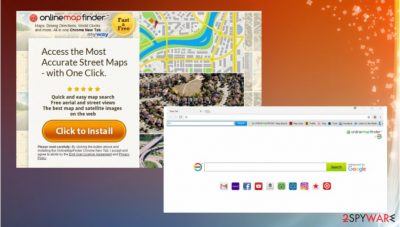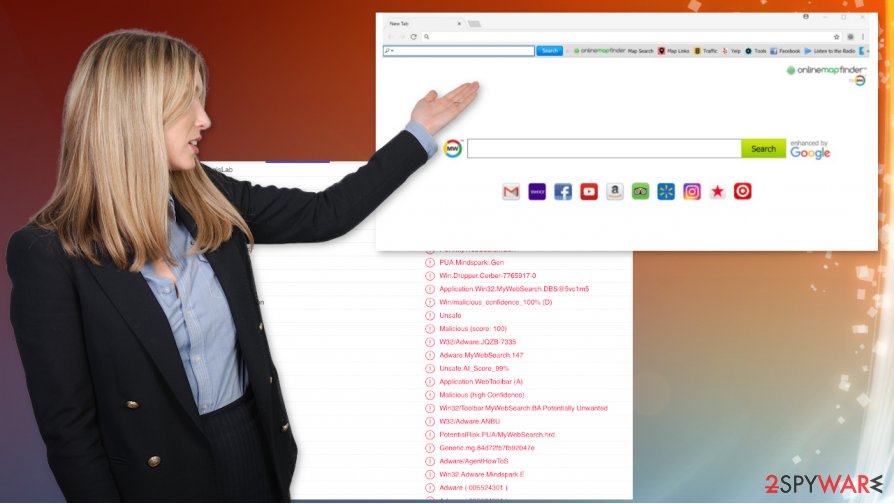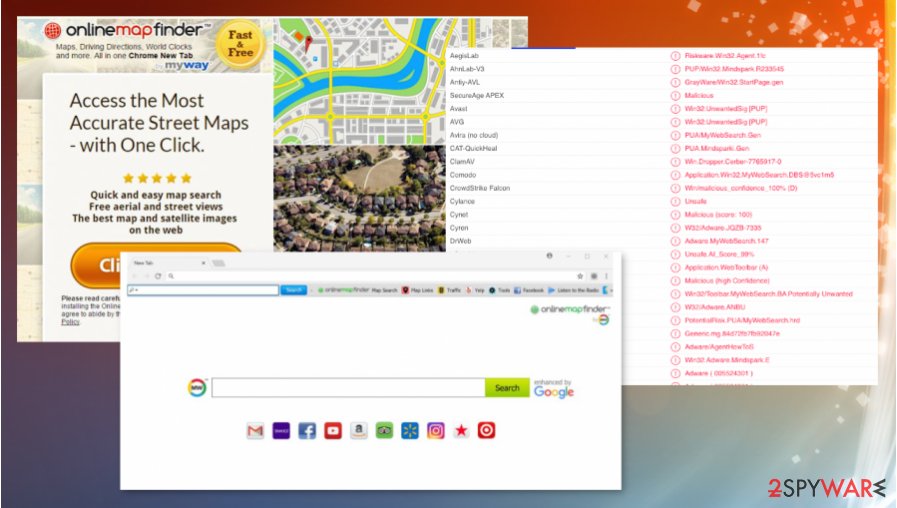OnlineMapFinder Toolbar (Free Guide) - Removal Instructions
OnlineMapFinder Toolbar Removal Guide
What is OnlineMapFinder Toolbar?
OnlineMapFinder Toolbar – the browser plugin that gets bundled with freeware, so gets silently distributed

In this particular case, we want to warn you about OnlineMapFinder Toolbar that is represented as a useful tool and service while it is not giving any value for the user. However, no one mentions that in exchange for any services, you will be prompted to use MyWay search engine (powered by Ask), provided with sponsored links, advertisements, asked to share browsing-related information, and so on.
Thus, if you have noticed search.myway.com set as your default start page, search provider, and an OnlineMapFinder Toolbar installed on each of your web browsers, you should start worrying about unwanted activities. The particular application might not be malicious or damaging, but there are many third-party involvement issues.[1]
| Name | OnlineMapFinder |
|---|---|
| Type | Browser hijacker |
| Issues | The intruder triggers redirects and affects every online search attempt |
| Distribution | Freeware bundling and promotional advertisements are the most common methods used to trick people into installing such PUPs |
| Elimination | You need to remove OnlineMapFinder from the system, so the performance can be restored to normal. Make sure to use the anti-malware tool that can find and terminate the PUP completely |
| Repair | To restore affected functions or corrupted files, rely on PC repair tool like FortectIntego or alternate system optimizer compatible with your OS |
OnlineMapFinder Toolbar is closely related to advertisers, commercial content creators, other companies, and set to promote Ask search. Despite the fact that it's still deemed as a legitimate search provider, it should not be used due to the questionable search results. Thus, if you have been intrigued by bogus promises to have quick access to maps all over the globe, probably you already regret installing it.
If the virus gets installed, it may initiate various browser modifications and cause various inconveniences. First of all, it may install a toolbar on each of your web browsers, including Internet Explorer, Mozilla Firefox, and Google Chrome. If you need a guide that would explain the Online Map Finder removal process, you can find the instructions below.

After that, it may corrupt browser settings and set customized Ask search engine (search.myway.com) as a default start page and search engine. Second of all, it may start displaying sponsored search results and deliver lots of sponsored pop-ups. Unfortunately, but OnlineMapFinder Toolbar can make you visit irrelevant websites. As noted on the official page of this toolbar:
You hereby acknowledge and agree that by using an MS Product you may be exposed to Content that may be offensive, indecent or objectionable in your community […]
MS Products are exposed to various security issues, and should be regarded as unsecure. By accepting this Agreement, you acknowledge and accept that the MS Products and any information you download or offer to share by means of an MS Product, may be exposed to unauthorized access, interception, corruption, damage or misuse, and should be regarded as insecure. You accept all responsibility for such security risks and any damage resulting therefrom.
That may be unpopular third-party online shops that are trying to increase the number of visitors and buyers. However, that may also be compromised domains that do nothing else but spreads other PUPs or even viruses. You need to remove Online Map Finder as soon as you notice unwanted activities.

Although Online Map Finder Toolbar add-on is not dangerous on its own, it collaborates with third parties who may display links to unsafe websites. We have analyzed the Privacy Policy that is provided on the official website. The entire Policy is written in regard to MS Products. It is stated that “MS Products are exposed to various security issues, and should be regarded as unsecure.”
Having this in mind, you should be cautious if Online Map Finder Toolbar has already entered your computer. At best, you should take needed actions and remove these suspicious tools from the system right away. For that, you need a proper anti-malware program, so the PUP that triggers all the unwanted symptoms can be terminated properly. Especially, when the tool is detected by some AV tools.[2]
PUPs spread on its own, so you might not be the one that installed the Toolbar
This toolbar is a potentially unwanted program (PUP). It does not spread like a virus, malware, spyware, or other severe cyber threat. It can be downloaded from the official website as an individual application or installed from a file-sharing website as a component of a freeware bundle.[3] People often fall for allegations and claims, so the tool gets installed on purpose.
Anyway, it replaces the web browser's settings and starts initiating marketing campaigns immediately after infiltration. If you want to protect your computer from such infections, you have to install free software more attentively, i.e. select Advanced or Custom installation, detect 'optional components', and deselect each of them.
Ways to get rid of OnlineMapFinder Toolbar virus
You can either install a reliable anti-malware that would check your system thoroughly or rely on yourself and check the system manually. If you need a guide that would explain how to remove OnlineMapFinder Toolbar manually, you can find it down below.
However, there are other more reliable methods for OnlineMapFinder removal. Anti-malware tools are the ones that should be used in this case because there are other PUPs that run in the background and trigger issues with your device, the initial drop of the Toolbar, and other apps, browser-based material.
You may remove virus damage with a help of FortectIntego. SpyHunter 5Combo Cleaner and Malwarebytes are recommended to detect potentially unwanted programs and viruses with all their files and registry entries that are related to them.
Getting rid of OnlineMapFinder Toolbar. Follow these steps
Uninstall from Windows
Instructions for Windows 10/8 machines:
- Enter Control Panel into Windows search box and hit Enter or click on the search result.
- Under Programs, select Uninstall a program.

- From the list, find the entry of the suspicious program.
- Right-click on the application and select Uninstall.
- If User Account Control shows up, click Yes.
- Wait till uninstallation process is complete and click OK.

If you are Windows 7/XP user, proceed with the following instructions:
- Click on Windows Start > Control Panel located on the right pane (if you are Windows XP user, click on Add/Remove Programs).
- In Control Panel, select Programs > Uninstall a program.

- Pick the unwanted application by clicking on it once.
- At the top, click Uninstall/Change.
- In the confirmation prompt, pick Yes.
- Click OK once the removal process is finished.
Delete from macOS
Remove items from Applications folder:
- From the menu bar, select Go > Applications.
- In the Applications folder, look for all related entries.
- Click on the app and drag it to Trash (or right-click and pick Move to Trash)

To fully remove an unwanted app, you need to access Application Support, LaunchAgents, and LaunchDaemons folders and delete relevant files:
- Select Go > Go to Folder.
- Enter /Library/Application Support and click Go or press Enter.
- In the Application Support folder, look for any dubious entries and then delete them.
- Now enter /Library/LaunchAgents and /Library/LaunchDaemons folders the same way and terminate all the related .plist files.

Remove from Microsoft Edge
Delete unwanted extensions from MS Edge:
- Select Menu (three horizontal dots at the top-right of the browser window) and pick Extensions.
- From the list, pick the extension and click on the Gear icon.
- Click on Uninstall at the bottom.

Clear cookies and other browser data:
- Click on the Menu (three horizontal dots at the top-right of the browser window) and select Privacy & security.
- Under Clear browsing data, pick Choose what to clear.
- Select everything (apart from passwords, although you might want to include Media licenses as well, if applicable) and click on Clear.

Restore new tab and homepage settings:
- Click the menu icon and choose Settings.
- Then find On startup section.
- Click Disable if you found any suspicious domain.
Reset MS Edge if the above steps did not work:
- Press on Ctrl + Shift + Esc to open Task Manager.
- Click on More details arrow at the bottom of the window.
- Select Details tab.
- Now scroll down and locate every entry with Microsoft Edge name in it. Right-click on each of them and select End Task to stop MS Edge from running.

If this solution failed to help you, you need to use an advanced Edge reset method. Note that you need to backup your data before proceeding.
- Find the following folder on your computer: C:\\Users\\%username%\\AppData\\Local\\Packages\\Microsoft.MicrosoftEdge_8wekyb3d8bbwe.
- Press Ctrl + A on your keyboard to select all folders.
- Right-click on them and pick Delete

- Now right-click on the Start button and pick Windows PowerShell (Admin).
- When the new window opens, copy and paste the following command, and then press Enter:
Get-AppXPackage -AllUsers -Name Microsoft.MicrosoftEdge | Foreach {Add-AppxPackage -DisableDevelopmentMode -Register “$($_.InstallLocation)\\AppXManifest.xml” -Verbose

Instructions for Chromium-based Edge
Delete extensions from MS Edge (Chromium):
- Open Edge and click select Settings > Extensions.
- Delete unwanted extensions by clicking Remove.

Clear cache and site data:
- Click on Menu and go to Settings.
- Select Privacy, search and services.
- Under Clear browsing data, pick Choose what to clear.
- Under Time range, pick All time.
- Select Clear now.

Reset Chromium-based MS Edge:
- Click on Menu and select Settings.
- On the left side, pick Reset settings.
- Select Restore settings to their default values.
- Confirm with Reset.

Remove from Mozilla Firefox (FF)
Remove dangerous extensions:
- Open Mozilla Firefox browser and click on the Menu (three horizontal lines at the top-right of the window).
- Select Add-ons.
- In here, select unwanted plugin and click Remove.

Reset the homepage:
- Click three horizontal lines at the top right corner to open the menu.
- Choose Options.
- Under Home options, enter your preferred site that will open every time you newly open the Mozilla Firefox.
Clear cookies and site data:
- Click Menu and pick Settings.
- Go to Privacy & Security section.
- Scroll down to locate Cookies and Site Data.
- Click on Clear Data…
- Select Cookies and Site Data, as well as Cached Web Content and press Clear.

Reset Mozilla Firefox
If clearing the browser as explained above did not help, reset Mozilla Firefox:
- Open Mozilla Firefox browser and click the Menu.
- Go to Help and then choose Troubleshooting Information.

- Under Give Firefox a tune up section, click on Refresh Firefox…
- Once the pop-up shows up, confirm the action by pressing on Refresh Firefox.

Remove from Google Chrome
Delete malicious extensions from Google Chrome:
- Open Google Chrome, click on the Menu (three vertical dots at the top-right corner) and select More tools > Extensions.
- In the newly opened window, you will see all the installed extensions. Uninstall all the suspicious plugins that might be related to the unwanted program by clicking Remove.

Clear cache and web data from Chrome:
- Click on Menu and pick Settings.
- Under Privacy and security, select Clear browsing data.
- Select Browsing history, Cookies and other site data, as well as Cached images and files.
- Click Clear data.

Change your homepage:
- Click menu and choose Settings.
- Look for a suspicious site in the On startup section.
- Click on Open a specific or set of pages and click on three dots to find the Remove option.
Reset Google Chrome:
If the previous methods did not help you, reset Google Chrome to eliminate all the unwanted components:
- Click on Menu and select Settings.
- In the Settings, scroll down and click Advanced.
- Scroll down and locate Reset and clean up section.
- Now click Restore settings to their original defaults.
- Confirm with Reset settings.

Delete from Safari
Remove unwanted extensions from Safari:
- Click Safari > Preferences…
- In the new window, pick Extensions.
- Select the unwanted extension and select Uninstall.

Clear cookies and other website data from Safari:
- Click Safari > Clear History…
- From the drop-down menu under Clear, pick all history.
- Confirm with Clear History.

Reset Safari if the above-mentioned steps did not help you:
- Click Safari > Preferences…
- Go to Advanced tab.
- Tick the Show Develop menu in menu bar.
- From the menu bar, click Develop, and then select Empty Caches.

After uninstalling this potentially unwanted program (PUP) and fixing each of your web browsers, we recommend you to scan your PC system with a reputable anti-spyware. This will help you to get rid of OnlineMapFinder Toolbar registry traces and will also identify related parasites or possible malware infections on your computer. For that you can use our top-rated malware remover: FortectIntego, SpyHunter 5Combo Cleaner or Malwarebytes.
How to prevent from getting system tools
Access your website securely from any location
When you work on the domain, site, blog, or different project that requires constant management, content creation, or coding, you may need to connect to the server and content management service more often. The best solution for creating a tighter network could be a dedicated/fixed IP address.
If you make your IP address static and set to your device, you can connect to the CMS from any location and do not create any additional issues for the server or network manager that needs to monitor connections and activities. VPN software providers like Private Internet Access can help you with such settings and offer the option to control the online reputation and manage projects easily from any part of the world.
Recover files after data-affecting malware attacks
While much of the data can be accidentally deleted due to various reasons, malware is one of the main culprits that can cause loss of pictures, documents, videos, and other important files. More serious malware infections lead to significant data loss when your documents, system files, and images get encrypted. In particular, ransomware is is a type of malware that focuses on such functions, so your files become useless without an ability to access them.
Even though there is little to no possibility to recover after file-locking threats, some applications have features for data recovery in the system. In some cases, Data Recovery Pro can also help to recover at least some portion of your data after data-locking virus infection or general cyber infection.
- ^ Potentially unwanted program. Wikipedia. The free encyclopedia.
- ^ OnlineMapFinder detection. VirusTotal. Online malware scanner.
- ^ Liam Tung. Google: Unwanted bundled software is way more aggressive than malware. ZDNet. Technology and cybersecurity news.























